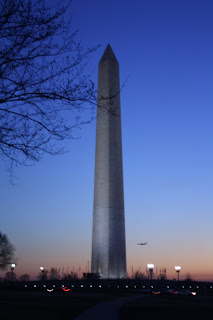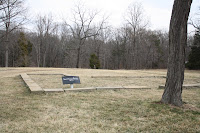 Leon greeted us at the East Falls Church Metro platform. "Need help?" he offered.
Leon greeted us at the East Falls Church Metro platform. "Need help?" he offered."I think we've got it today," said Andy, putting cash in the ticket machine. "I'm only buying one-way today, because with predictions of rain for afternoon, we may come back before the 7:00 p.m. off-peak."
Leon grinned and offered to take our picture before other customers asked his advice about parking in the lot nearby and finding a taxi--all answers, delivered with a smile.
 "Next year, I'm retiring too," he called, waving goodbye as we rode up the escalator to the overhead tracks. In D.C., Metro is definitely the way to go. Punctual to the minute and clean as could be, the commuter railroad took us from East Falls Church underground to the Federal Center SW station for $2.40 each, no parking fees and an easy walk to the new National Museum of the American Indian, the 18th Smithsonian Institution.
"Next year, I'm retiring too," he called, waving goodbye as we rode up the escalator to the overhead tracks. In D.C., Metro is definitely the way to go. Punctual to the minute and clean as could be, the commuter railroad took us from East Falls Church underground to the Federal Center SW station for $2.40 each, no parking fees and an easy walk to the new National Museum of the American Indian, the 18th Smithsonian Institution.At the 10:00 a.m. opening, not more than 15 people gathered in Lelawi Theater for the 13-minute introductory presentation of Who We Are. Named in the Delaware tongue for "in the middle," Lelawi, a theater in the round with 120 seats, includes a ceiling show with tiny stars and a partial globe for Mother Earth in the center of the floor, as well as the in-the-round film. After the video about different tribes, we explored the displays, 800,000 pieces of aesthetic, historical and spiritual significance in a collection that spans more than 10,000 years of heritage in the United States, Canada and Latin America. The Our Universe section presented native beliefs, and Our Peoples showed native history.
 I learned about the upsurge in money in Europe after 1500 because of the silver and gold from the Americas. From 1500 to 1650 Spain shipped 35 million pounds of gold and silver to Seville, all mined by native peoples.
I learned about the upsurge in money in Europe after 1500 because of the silver and gold from the Americas. From 1500 to 1650 Spain shipped 35 million pounds of gold and silver to Seville, all mined by native peoples.
Another section explained how products from the Americas--potatoes, tobacco, chocolate and corn--had changed the world. Other exhibits showed Indian beliefs in an unseen spirit world. Indians felt that deceased family members would return and that death is a continuation of life. They celebrated this with Day of the Dead. The Spanish colonizers who brought their own way of worship and Roman Catholic beliefs in one God to the western hemisphere tried to wipe out the Day of the Dead. When they failed to stop Indians from dancing and performing their ceremonies, the Spanish moved the celebration to November 1 and 2 and called it All Saints Day and All Souls Day.
 I read about survivance. I didn't know there was such a word. The plaque said it meant more than survival. "Survivance means redefining ourselves, holding on to ancient principles while eagerly embracing change. It means doing what is necessary to keep our cultures alive."
I read about survivance. I didn't know there was such a word. The plaque said it meant more than survival. "Survivance means redefining ourselves, holding on to ancient principles while eagerly embracing change. It means doing what is necessary to keep our cultures alive."
I wandered from section to section along the outside walls of the fourth floor. Each tribe had its own display about culture. I missed the artifacts and the art. Many tribal names I had never heard before. And back at the stairway I found Andy sitting, reading and waiting for me. "I'm disappointed," he said. "The presentation is disjointed and there are no sand paintings, almost no kachinas and not even much weaving. It isn't what I expected."

"I just can't process so much all at once," I said. I hadn't thought about it before, but each tribe expressed its own story in its own way, so there wasn't much cohesiveness. He was right, and that might have caused my feelings of burn out. I was overwhelmed, but it was due to my own expectations.
We started the third floor together. It offered more of the same--an Our Lives focus on contemporary people.
We started the third floor together. It offered more of the same--an Our Lives focus on contemporary people.
At the Mitsitam Cafe on the second floor, we found the break we needed at a place serving all authentic native foods. Andy ordered two Mexican spicy hot chocolates to sip with our granola bar lunch. Coffee cost more.
In the first floor Potomac Atrium, native American Dennis beat a skin drum head and sang Kiowa war journey songs, typical of the southern plains around Oklahoma. "The sounds are not exactly words," he explained,. "They are emotions, sort of like singing 'Fa la la la laaa... la...la...la...la.'"
"I am Dennis Zotigh. I am Kiowa, Santee Dakota and Ohkay Owingeh Pueblo," said Dennis. I hadn't heard much about any of those tribes. He told a small audience seated on benches around the atrium that Indian tribes in the U.S. numbered more than 600 with 215 different dialects. No wonder the tribal names had no familiar ring for me. "There are about 2,000 tribes overall in the western hemisphere," he said. That would explain the disjointed nature of the upper floors and my sense of disconcertedness. I photographed the Hawaiian koawood canoe with its hauwood and wili-wili wood float and the canoe of totora reeds from Lake Titicaca.
"How could anyone fit inside that canoe?" asked Andy. "Did you see how tight it is? I'd never fit. "I shrugged. "It would hold you in and keep you dry."
"I am Dennis Zotigh. I am Kiowa, Santee Dakota and Ohkay Owingeh Pueblo," said Dennis. I hadn't heard much about any of those tribes. He told a small audience seated on benches around the atrium that Indian tribes in the U.S. numbered more than 600 with 215 different dialects. No wonder the tribal names had no familiar ring for me. "There are about 2,000 tribes overall in the western hemisphere," he said. That would explain the disjointed nature of the upper floors and my sense of disconcertedness. I photographed the Hawaiian koawood canoe with its hauwood and wili-wili wood float and the canoe of totora reeds from Lake Titicaca.
"How could anyone fit inside that canoe?" asked Andy. "Did you see how tight it is? I'd never fit. "I shrugged. "It would hold you in and keep you dry."
"It's not raining yet," said Andy.















 The bronze statue of a standing Jefferson by Rudulph Evans dominated the center. It looked cleaned.
The bronze statue of a standing Jefferson by Rudulph Evans dominated the center. It looked cleaned.

















 A coating of soft snow covered the ground and left paths muddy. "Trails crisscross everywhere in this park," said Andy. He chose three short trails to the lookouts. Signs warned of unpredictable currents in the river and dangerous rock embankments.
A coating of soft snow covered the ground and left paths muddy. "Trails crisscross everywhere in this park," said Andy. He chose three short trails to the lookouts. Signs warned of unpredictable currents in the river and dangerous rock embankments.








 At Spotsylvania Court House Grant's law of attrition impacted Lee. "I'll wear him down," said Grant. At Bloody Angle, a bulge in the Confederate defense, Grant broke through by sending more and more soldiers on the offensive near the Mule Shoe Salient. Heavy fighting, some of the bloodiest in the war, swirled around the Neill McCoull farm on May 10, 1864, and again on May 12. Andy and I walked around the foundation. Quiet fields and groves of trees stretched in every direction from the small rise. McCoull had been away the day of the battle, and his three sisters hid in the basement. They emerged to carnage on May 10. Weeks later, 1,492 Union soldiers were buried in their front yard. Only a grassy knoll remains. In tact earthworks mark Heth's Salient where General Henry Heth repulsed Major General Ambrose Burnside's Union corps. Farther along the Fredericksburg Road Union soldiers held the lifeline to Fredericksburg. Lee tried repeatedly but failed to dislodge them. His biggest gain militarily was the death of the highest general killed in the war, General John Sedgwick. Admonishing his troops about the lack of danger from sharpshooters and their inability to hit anything, Sedgwick was shot through the head by a sharpshooter.
At Spotsylvania Court House Grant's law of attrition impacted Lee. "I'll wear him down," said Grant. At Bloody Angle, a bulge in the Confederate defense, Grant broke through by sending more and more soldiers on the offensive near the Mule Shoe Salient. Heavy fighting, some of the bloodiest in the war, swirled around the Neill McCoull farm on May 10, 1864, and again on May 12. Andy and I walked around the foundation. Quiet fields and groves of trees stretched in every direction from the small rise. McCoull had been away the day of the battle, and his three sisters hid in the basement. They emerged to carnage on May 10. Weeks later, 1,492 Union soldiers were buried in their front yard. Only a grassy knoll remains. In tact earthworks mark Heth's Salient where General Henry Heth repulsed Major General Ambrose Burnside's Union corps. Farther along the Fredericksburg Road Union soldiers held the lifeline to Fredericksburg. Lee tried repeatedly but failed to dislodge them. His biggest gain militarily was the death of the highest general killed in the war, General John Sedgwick. Admonishing his troops about the lack of danger from sharpshooters and their inability to hit anything, Sedgwick was shot through the head by a sharpshooter.






